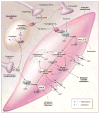Physiology of penile erection and pathophysiology of erectile dysfunction
- PMID: 16291031
- PMCID: PMC1351051
- DOI: 10.1016/j.ucl.2005.08.007
Physiology of penile erection and pathophysiology of erectile dysfunction
Abstract
This article reviews the physiology of penile erection, the components of erectile function, and the pathophysiology of erectile dysfunction. The molecular and clinical under-standing of erectile function continues to gain ground at a particularly fast rate. Advances in gene discovery have aided greatly in working knowledge of smooth muscle relaxation/contraction pathways. The understanding of the nitric oxide pathway has aided not only in the molecular understanding of the tumescence but also greatly in the therapy of erectile dysfunction.
Figures



References
-
- Sattar AA, Salpigides G, Vanderhaeghen JJ, et al. Cavernous oxygen tension and smooth muscle fibers: relation and function. J Urol. 1995;154:1736. - PubMed
-
- Bosch RJ, Benard F, Aboseif SR, et al. Penile detumescence: characterization of three phases. J Urol. 1991;146:867. - PubMed
-
- Lue TF, Takamura T, Schmidt RA, et al. Hemodynamics of erection in the monkey. J Urol. 1983;130:1237. - PubMed
-
- Saenz de Tejada I, Goldstein I, Azadzoi K, et al. Impaired neurogenic and endothelium-mediated relaxation of penile smooth muscle from diabetic men with impotence. N Engl J Med. 1989;320:1025. - PubMed
-
- Ignarro LJ, Bush PA, Buga GM, et al. Nitric oxide and cyclic GMP formation upon electrical field stimulation cause relaxation of corpus cavernosum smooth muscle. Biochem Biophys Res Commun. 1990;170:843. - PubMed
Publication types
MeSH terms
Grants and funding
LinkOut - more resources
Full Text Sources
Other Literature Sources
Medical

